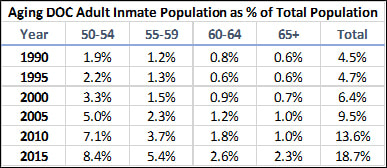A Primer on Overcrowded Prisons, Part II
Percent of old inmates with costly medical problems keeps rising.
How long can the Department of Corrections ignore the increasing numbers of prison inmates with some sort of disability?
At least another two years, according to the state budget.
DOC asked for $42.6 million to build a facility for those inmates. The State Legislature and the governor authorized $0. It will study the issue instead.
This is part 2 of our look at state prisons, how crowded they are, and what the Department of Corrections said during budget preparation it needed to fix and maintain them. Part 1 is here.
This primer does not really address the consequences of the crowding and physical shortcomings of the institutions – the impacts on inmates and staff. But we sure hope you will keep them in mind as you consider the price of mass incarceration.
Institution: Dodge Correctional Institution, Waupun
Classification: Maximum security
Capital budget request: None
Institution: Jackson Correctional Institution, Black River Falls
Classification: Medium security
Capital budget request: None
Institution: Milwaukee Women’s Correctional Center, Milwaukee
Classification: Minimum Security
Capital budget request: None
Institution: Proposed assisted living facility
Classification: Medium security
Capital budget request: $42,662,000
Status: Rejected
From the request: This project would build a new facility to help the DOC address the growing number of inmates – regardless of age – that require living or program accommodations, increased access to medical resources due to a lack of mobility, diminishing cognitive ability, poor physical health, or other impairments that prevent an inmate from being fully independent. Additionally, specialized services are becoming necessary for some inmates due to complications associated with aging such as severe mobility issues, Alzheimer’s disease, Parkinson’s disease, dementia, and other medical conditions. …
In the DOC system inmates requiring assisted living are currently housed throughout the entire Division of Adult Institutions (DAI) system of institutions. Several institutions such as the Dodge Correctional Institution infirmary or Oshkosh Correctional Institution have a relatively high concentration of these inmates.
Total inmate population within DAI has remained relatively constant over the past 10 years, while the number of inmates over the age of 45 has been steadily increasing. The number of inmates 45 years of age or older was 3,421 in July 2003 and 5,906 in July 2012. This is a 73% increase over a 10 year period or an average annual increase of over 6%.
As of March 2013, inmates 40 years or older with sentences of 20 or more years to release was 1,374. This older population will likely be spending their 60’s, 70’s and 80’s in a DOC institution. …
The number of inmates 45 years of age or older was 3,421 in July 2003 and 5,906 in July 2012. This is a 73% increase over a 10 year period or an average annual increase of over 6%.
In March 2008, a DAI Site ADA Accessibility Survey indicated there were 286 inmates requiring the use of a wheelchair. Of the 286 wheelchair users, 166 were permanent users and 32 were in oversized wheelchairs. These inmates will require ADA cells, showers, bathrooms, access to electrical outlets to run medical appliances, etc.
Other inmates are not necessarily wheelchair bound but have other disease such as cerebral palsy, Alzheimer’s disease or Parkinson’s disease. As these inmates progress in their disease, they typically need an increased level of medical attention or other accommodations. For example, an inmate with short-term memory loss can still be held in a GP cell, but may need constant reminders to take their on-person medication, have a hard time remembering which cell is theirs, requires a lower bunk and may need a bathroom located nearby. These inmates often develop other comorbidities such as hypertension, liver disease, chronic obstructive pulmonary disease (COPD), congestive heart failure, and/or significant cardiovascular conditions.
Without an assisted living facility the number of inmates requiring HSU and infirmary care will continue to increase. HSUs and infirmary units do not have the staff, space or equipment to deal with these patients on a regular basis. HSUs and infirmaries will need to be expanded to include:
- Access to “24/7” on-site medical resources.
- Medication distribution and monitoring needs.
- Access to on-site specialized therapies such as occupational therapy, physical therapy, and recreational therapy.
- Specialized transport services by DOC that accommodate disability or medical needs.
- Effective access to local, off-site emergency responders and ambulance services.
In addition to these improvements, housing improvements will also need to include the following:
- Activities for daily living.
- Access to cells meeting the minimum ADA width door frames and turning radius for wheelchairs.
- Access to toilets/showers/bathing (currently for prisons ADA requires 5% or one accessible stall, whichever is greater. For long term care facilities, ADA requires at least 50% of accessible toilets).
- Single bed cells versus bunk beds.
- Bed rails.
- Electrical outlets and shelving to accommodate required medical equipment.
Gretchen Schuldt writes a blog for Wisconsin Justice Initiative, whose mission is “To improve the quality of justice in Wisconsin by educating the public about legal issues and encouraging civic engagement in and debate about the judicial system and its operation.
More about the Overcrowding of Wisconsin's Prisons
- Op Ed: Legislature Must Act on Prison Overcrowding - State Sen. Jon Erpenbach - Dec 16th, 2017
- Columbia Prison at 153% of Capacity - Gretchen Schuldt - Dec 15th, 2017
- Waupun, Taycheedah at 140% of Capacity - Gretchen Schuldt - Dec 1st, 2017
- A Primer on Overcrowded Prisons, Part II - Gretchen Schuldt - Nov 24th, 2017
- A Primer On Crowded State Prisons - Gretchen Schuldt - Nov 20th, 2017
Read more about Overcrowding of Wisconsin's Prisons here
Our Crowded Prisons
-
County Jails Handle State Prison Overflow
 Feb 20th, 2018 by Gretchen Schuldt
Feb 20th, 2018 by Gretchen Schuldt
-
Racine County Prisons Over Capacity
 Feb 2nd, 2018 by Gretchen Schuldt
Feb 2nd, 2018 by Gretchen Schuldt
-
Ellsworth Prison at 213% of Capacity
 Jan 11th, 2018 by Gretchen Schuldt
Jan 11th, 2018 by Gretchen Schuldt























